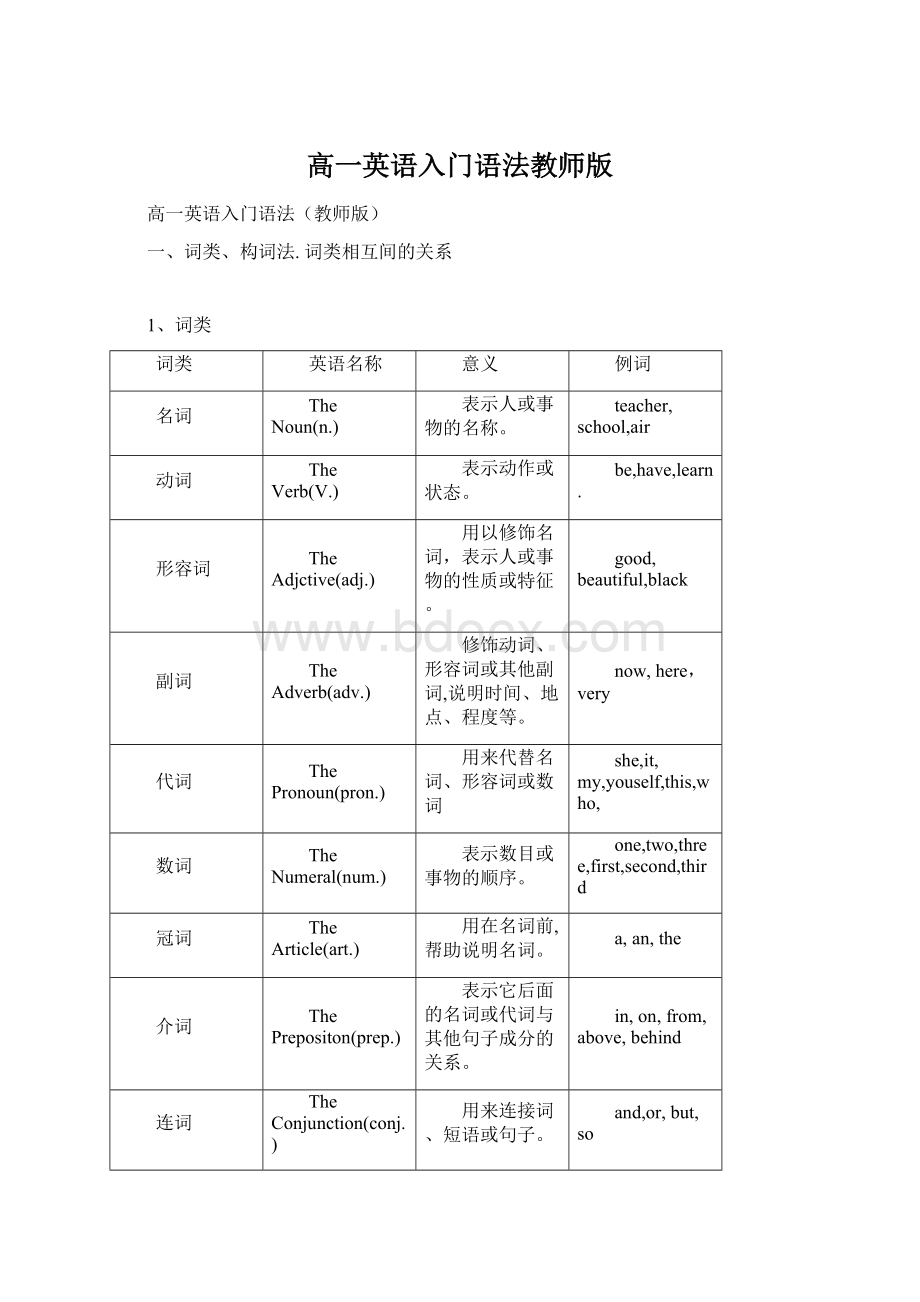高一英语入门语法教师版.docx
《高一英语入门语法教师版.docx》由会员分享,可在线阅读,更多相关《高一英语入门语法教师版.docx(26页珍藏版)》请在冰豆网上搜索。

高一英语入门语法教师版
高一英语入门语法(教师版)
一、词类、构词法.词类相互间的关系
1、词类
词类
英语名称
意义
例词
名词
TheNoun(n.)
表示人或事物的名称。
teacher,school,air
动词
TheVerb(V.)
表示动作或状态。
be,have,learn.
形容词
TheAdjctive(adj.)
用以修饰名词,表示人或事物的性质或特征。
good,beautiful,black
副词
TheAdverb(adv.)
修饰动词、形容词或其他副词,说明时间、地点、程度等。
now,here,very
代词
ThePronoun(pron.)
用来代替名词、形容词或数词
she,it,my,youself,this,who,
数词
TheNumeral(num.)
表示数目或事物的顺序。
one,two,three,first,second,third
冠词
TheArticle(art.)
用在名词前,帮助说明名词。
a,an,the
介词
ThePrepositon(prep.)
表示它后面的名词或代词与其他句子成分的关系。
in,on,from,above,behind
连词
TheConjunction(conj.)
用来连接词、短语或句子。
and,or,but,so
感叹词
TheInterjection(interj.)
表示喜、怒、哀、乐等感情。
oh,well,hi,hello
2.构词法
1)合成法:
把两个或两个以上的词合成为一个新词。
如:
_classmate_同学,classroom教室,basketball篮球,playground操场
2)派生法:
在一个单词前或后加上一个词缀,变成一个新词。
(1)派生名词:
①动词+__er/or__driver司机,teacher教师,inventor发明家,visitor参观者
名词+erfarmer农民,officer政府官员
②动词+ingswimming游泳,building楼房,meeting会议
③动词+tioncongratulation祝贺,invention发明,graduation毕业
④动词+mentagreement_同意,disagreement不同意,settlement定居点
⑤形容词+nesskindness善良,carelessness粗心,loneliness孤独
⑥形容词t→ceignorance无知,importance重要性,confidence自信
(2)派生形容词:
①名词+ycloudy,snowy,sunny晴天的,dusty积满灰尘的
②名词+fulcareful细心的,helpful有助的,useful有用的,powerful强大的
名词+lesscareless粗心的,helpless无助的,useless无用的,powerless无权力的
③动词+ing_intertesting有趣的,exciting令人兴奋的,surprising令人惊讶的
动词+edinterested感兴趣的,exciting兴奋的,surprised惊讶的,concerned担心的
名词+ousdangerous危险的,nervous紧张的,
其他friendly热情的,daily(每日的),English英国的,Geman德国的
(3)派生副词:
①形容词+lyslowly,fluently,gradually,angry→angrily(生气地)
②其它good→well,possible→possibly,probable→probably
3)转换法:
一个单词由某一种词类转为另一种词类。
(1)形容词→动词,如:
dry(干燥的)→dry(吹干),clean(干净的)→clean(打扫)
Dryhaircanbedamagedbywashingittoofrequently.
干性头发洗得太频繁容易受损。
Let'sdryourhairsowedon'tcatchcold.
我们把头发吹干,这样就不会感冒。
这地板挺干净。
Thefloorissoclean.
今天轮到我们打扫教室。
It’sourdutytocleanourclassroom.
(2)动词→名词,如:
look,walk,rest,work,learn学习,swim,go,talk聊天
请看黑板。
Pleaselookattheblackboard.
让我看看。
Letmehavealook.
(3)名词→动词,如:
hand(手)→hand(传递),face(脸)→face(面对/面向)
我们每个人都有一双手。
Everyoneofushasapairofhands.
请上交你们的作业。
Pleasehandinyourhomework.
她有一张圆圆的脸。
Shehasaroundface.
面对现实吧!
Facethereality!
(4)形容词→副词,如:
early→early,fast→fast
Theearlybirdcatchestheworm.(捷足先登)
ThismorningIgotupearly(早).
Iranfasttothefastfoodrestauranttobuysomefastfood.
(5)副词→连词,如:
when(什么时候)→when(当……时)
Whenareyougoinghome?
你什么时候回家?
当你孤单你会想起谁?
Whowillyouthinkofwhenyouarelonely?
(6)介词→副词,如:
in(到……里)→(在家),on(在…上)→on(进行,继续)
Hewasinhiscar.他坐在他的车里。
我今天早上打电脑给你,你不在家。
Itelephonedyouthismorning,butyouarenotin.
3.词类相互间的关系
1)形容词、数词通常修饰名词(有时名词也可以修饰另一个名词),形容词还可修饰代词。
那三个高大又强壮的男人都是篮球运动员。
Thethreetallandstrongmenareallbasketballplayers.
我有些有趣的事情要告诉你。
Ihavesomethinginterestingtotellyou.
2)副词常修饰动词、形容词和副词。
他哥哥足球踢得很好。
Herbrotherplaysfootballquitewell.
这个会议很重要。
Themeetingisveryimportant.
3)冠词只用于名词之前,辅助说明名词的含义。
我们教师前有一棵树,这棵树很高。
Thereisatreeinfrontofourclassroom.Thetreeisverytall.
4)介词与它后面的名词或代词构成介词短语。
今天我们一整天都呆在家里。
Westayedathomealldaytoday.
在他前面的那个女孩是谁?
Who’sthegirlinfrontofhim?
5)连词只起连接词、词组和句子的作用。
他和我都是好学生。
HeandIarebothgoodstudents.
请看黑板并回答我的问题。
Pleaselookattheblackboardandanswermyquestion.
她很丑,但是很善良。
Sheisugly,butsheissokind.
村里有个姑娘叫小芳。
ThereisagirlwhoiscalledXiaofanginourvillage.
二、句子成分
构成句子的各个部分叫做句子成分。
在英语中,句子成分有主要成分和次要成分;主要成分有主语和谓语;次要成分有表语、宾语、定语、状语、补足语和同位语。
1.主语:
主语是一个句子所叙述的主体,相当于句子的主题,说明这个句子讲的是什么人或什么事,一般位于句首,但在therebe结构、疑问句(当主语不是疑问词时)和倒装句中,主语位于谓语、助动词或情态动词后面。
主语可由名词、代词、数词、不定式、动名词、名词化的形容词和主语从句等充当。
例如:
Duringthe1990s,Americancountrymusichasbecomemoreandmorepopular.(名词)
WeoftenspeakEnglishinclass.(代词)
One-thirdofthestudentsinthisclassaregirls.(数词)
Toswimintheriverisagreatpleasure.(不定式)
Smokingdoesharmtothehealth.(动名词)
Therichshouldhelpthepoor.(名词化的形容词)
WhenwearegoingtohaveanEnglishtesthasnotbeendecided.(主语从句)
Itisnecessarytomasteraforeignlanguage.(it作形式主语,真正的主语为后面的不定式)
2.谓语:
谓语说明主语所做的动作或具有的特征和状态。
动词在句中作谓语,一般放在主语之后。
谓语的构成如下:
(1)简单谓语:
由一个动词或动词短语构成。
例如:
Hepracticesrunningeverymorning.
(2)复合谓语:
a)由情态动词或其他助动词加动词原形构成。
例如:
Youmaykeepthebookfortwoweeks.Hehascaughtabadcold.
b)由系动词加表语构成
例如:
Wearestudents.
3.表语:
表语用以说明主语的身份、特征和状态,它一般位于系动词(如be,become,
get,look,grow,turn,seem等)之后。
表语一般由名词、代词、形容词、分词、数词、不定式、动名词、介词短语、副词及表语从句表示。
例如:
OurteacherofEnglishisanAmerican.(名词)
Isityours?
(代词)
Theweatherhasturnedcold.(形容词)
Thespeechisexciting.(分词)
Threetimessevenistwentyone?
(数词)
HisjobistoteachEnglish.(不定式)
Hishobby(爱好)isplayingfootball.(动名词)
Themachinemustbeoutoforder.(介词短语)
Timeisup.Theclassisover.(副词)
Thetruthisthathehasneverbeenabroad.(表语从句)
4.宾语:
宾语表示动作的对象或承爱者,一般位于及物动词和介词后面。
例如:
Theywenttoseeanexhibition(展览)yesterday.(名词)
Theheavyrainpreventedmeformcomingtoschoolontime.(代词)
Howmanydictionariesdoyouhave?
Ihavefive.(数词)
Theyhelpedtheoldwiththeirhouseworkyesterday.(名词化形容词)
Hepretendednottoseeme.(不定式短语)
Ienjoylisteningtopopularmusic.(动名词短语)
Ithink(that)heisfitforhisoffice.(宾语从句)
宾语种类:
(1)双宾语(间接宾语+直接宾语),例如:
Lendmeyourdictionary,please.
(2)复合宾语(宾语+宾补),例如:
Theyelectedhimtheirmonitor.
5.补足语(宾语补足语和主语补足语):
a)宾语补足语:
英语中有些及物动词,除有一个直接宾语以外,还要有一个宾语补语才能使句子的意义完整。
带有宾语补足语的一般句型为:
某些及物动词(如make等+宾语+宾补)。
宾补可由名词、形容词、副词、不定式、分词、介词短语和从句充当。
例如:
HisfathernamedhimDongming.(名词)
Theypaintedtheirboatwhite.(形容词)
Letthefreshairin.(副词)
Youmustn’tforcehimtolendhismoneytoyou.(不定式短语)
Wesawherenteringtheroom.(现在分词短语)
Wefoundeverythinginthelabingoodorder.(介词短语)
Wewillsoonmakeourcitywhatyourcityisnow.(从句)
b)主语补足语:
补充说明主语的叫主语补足语。
1.ThepoetLiHediedyoung.=ThepoetLiHediedandhewasyoung.
诗人李贺年轻时就死了。
(形容词)
2.Hereturnedahero.=Hereturnedandhewasahero.
他回来时成了一个英雄。
(名词)
6.定语:
修饰名词或代词的词、短语或从句称为定语。
定语可由以下等成分表示:
Guilinisabeautifulcity.(形容词)
Chinaisadevelopingcountry;Americaisadevelopedcountry.(分词)
Therearethirtywomenteachersisourschool.(名词)
HisrapidprogressinEnglishmadeussurprised.(代词)
Ourmonitorisalwaysthefirsttoentertheclassroom.(不定式短语)
Theteachingplanfornexttermhasbeenworkedout.(动名词)
HeisreadinganarticleabouthowtolearnEnglish.(介词短语)
7.状语:
修饰动词、形容词、副词或整个句子,说明动作发生的时间,地点,条件,目的,原因等,或说明动作的状态特征的句子成分叫做状语。
例如:
Lighttravelsmostquickly.(副词及副词性词组)
Hehaslivedinthecityfortenyears.(介词短语)
Heisproudtohavepassedthenationalcollegeentranceexamination.(不定式短语)
Heisintheroommakingamodelplane.(分词短语)
Waitaminute.(名词)
Onceyoubegin,youmustcontinue.(状语从句)
状语种类如下:
Howaboutmeetingagainatsix?
(时间状语)
Lastnightshedidn’tgotothedancepartybecauseoftherain.(原因状语)
Ishallgothereifitdoesn’train.(条件状语)
MrSmithlivesonthethirdfloor.(地点状语)
Sheputtheeggsintothebasketwithgreatcare.(方式状语)
Shecameinwithadictionaryinherhand.(伴随状语)
Inordertocatchupwiththeothers,Imustworkharder.(目的状语)
Hewassotiredthathefellasleepimmediately.(结果状语)
Sheworksveryhardthoughsheisold.(让步状语)
Iamtallerthanheis.(比较状语)
【边讲边练】
一.分析下列句子中划线部分的句子成分:
(1)Mybrotherhasn'tdonehishomework.
(2)Theysmiledhappily.
(3)Hegavemeabookyesterday.
(4)Theymadehimmonitoroftheclass.
(5)Ifyougoacrossthebridgeyouwillfindthemuseumontheleft.
(6)YouwillfinditusefultolearnEnglishafteryouleaveschool.
(7)Theydidn'tknowwho"FatherChristmas"reallyis.
(8)Heisaqualifiedteacherinourschool.
(9)Someofthestudentswanttogoswimming
三、简单句的五种基本句型(fiveBasicSentencePatterns)
英语中句子无论怎样变化,归根结底都是由以下五种基本句型组合、扩展、变化而来的:
1)主 + 谓(不及物动词)
I work.我工作。
2)主 + 谓 (及物动词)+ 宾
She studies English. 她学英语。
3)主 +谓 (及物动词)+ 间宾 + 直宾例如:
My mother made me a new dress. 我母亲给我做了一件新衣裳。
4)主 + 谓(及物动词) + 宾 + 宾补 Time would prove me right. 时间会证明我是对的。
5)主 + 系(动词) + 表
John is busy. 约翰忙。
说明:
在主系表结构中,系动词有两类需要区别对待:
一类是be动词。
另一类是其它系动词(主要是感官动词和使役动词).如:
get,become,go,turn,grow,sound,look,taste,smell,seem,appear,remain,keep,stay,prove等,后面一般跟形容词或由动词+ing或ed变化而来的形容词做表语,而become还可以跟名词和过去分词作表语。
例如:
Theweatherisgettingcoldandcoldwiththeseasoncomingintothewinter.
随着冬天的来临,天气越来越冷了。
Hehasbecomeacollegestudent.他已经成了一名大学生。
Soontheroombecomecrowed.不久,房子就很拥挤了。
Thefoodgoesbad.食物变质了。
Theleavesoftreesturngreeninspring.树叶春天变绿了。
Thewindsoundsstrong.风声听起来很大。
Helooksyoungerthanheis.他看起来比实际年龄要小。
Thedishtastesgood.这道菜很好吃。
Heseemsilltoday.他似乎病了。
Thesituationremainedunchanged.情况未发生变化。
Marykeepssilentinthediscussion.讨论中玛丽保持沉默。
6)therebe句型和have(has)表示“有”的不同
1.“Therebe句型”表达“有”时,说明的是“存在关系”,即“有某物在某处”,如:
Therearesomanypeopleontheplayground.(操场上有许多人)。
“Have/has”表“有”时,表示“所属关系“,即“某物为某人所拥有”或“部分是整体的一部分”。
如:
Ihaveahousewithabeautifulgarden.我有一套带花园的房子。
Thebuildinghasthirtyrooms.这栋楼有三十个房间。
2.根据句意的需要,“therebe句型”的结构还有如下一些变化形式:
Thereisgoingtobe/Therewillbe(将有……)
Thereusedtobe(曾经有……)
Thereseemstobe…(似乎有……)
Therehappen(s)tobe(a)…(碰巧有……)
Therelive(s)/lie(s)/stand(s)/stay(s)/exist(s)/…有……
运用“therebe句型”常犯的错误形式有如下两种:
(1)Therehave/hasmanypeopleinmyfamily.(误)
Therearemanypeopleinmyfamily.(正)
(2)Thereisnoonewaswaiting(误)
Thereisnoonewaiting/Noonewaswaiting(正)
练习:
根据英语的基本句型,翻译下面的句子:
(一)主语+谓语(S+V)
1. 他工作很努力。
_______________________________________________________________
2. 外国游客将于本周六抵达。
_______________________________________________________________
3. 他和他的妻子两年前居住在英国。
_______________________________________________________________
(二)主语+系动词+表语(S+P